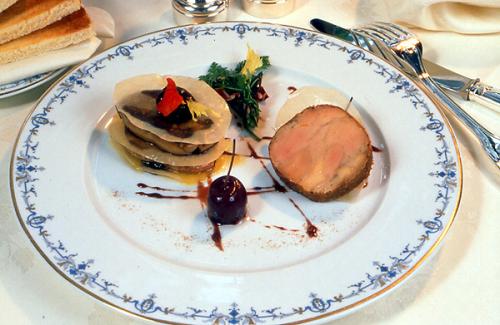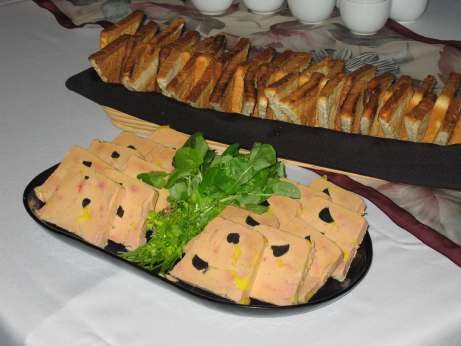How to make a terrine of foie gras
Today, it’s virtually impossible to find a menu from a top restaurant the doesn’t include something made with fresh foie gras, a duck or goose liver product that dates back to the Egyptians of 2500 B.C. Thankfully, availability of fresh foie gras (pronounced: fooah-grah) is only as far as your higher-end grocery stores or markets. The effort is worth it, especially for anyone who hasn’t experienced this extreme delight. Even people who hate liver are often won over by the extraordinary taste and creamy texture. Serves 18 as a first course appetizer or brunch item.

Things you’ll need
- 1 ceramic terrine baking dish, about 10-inches by 3-inches by 3-inches
- deep roasting pan big enough for the terrine to sit in
- sharp French knife
- cutting table
- parchment or wax paper
- large mixing bowl
- small mixing bowl
- large serving platter
- 2 fresh whole duck livers (each about 1½ lbs.), “A” quality if possible
- ¾ tbsp. sea salt
- 1 tsp. freshly ground pepper
- pinch of ground cinnamon
- pinch of ground allspice
- pinch of ground cloves
- pinch of nutmeg
- 1 tbsp. Cognac, or best Brandy available

Procedure Steps
- Separate the two lobes of the raw duck liver by gently pulling them apart. Scrape away any remaining traces of green bile and allow the foie gras to warm up slightly so it is more manageable to clean. (Be careful not to let it get too warm or it will melt in your hands.)
- To clean the foie gras, use a small knife and carefully dig into the middle of each lobe, slipping the vein under the knife tip and pulling it out. Gently pull out any other veins you see throughout the liver with a knife or your fingers. The liver may begin to break apart into chunks, but that makes no matter if the pieces are large chunks and not too small. Fill the large bowl with ice water and let the foie gras chunks soak for 5 hours covered in your refrigerator.
- When ready to begin, preheat the oven to 250 degrees. In a small bowl, combine the spices together and mix well. Remove the livers from the ice bath, dry them with paper towels, and sprinkle them evenly with the spice mixture. Place half of the liver pieces into a heavy terrine, smooth side down (they should almost completely fill the lower half of the terrine). Place the remaining pieces of liver on top, smooth side up (now the terrine should be almost completely filled).
- Pour the Cognac over the top, and cover the top of the terrine with parchment paper cut just to fit over the top edge, and press down slightly with your hands. Place the terrine in the deep roasting pan, then fill the inside of the roasting pan with simmering hot water. Fill half way up to the sides of the terrine baking dish.
- Carefully put the pan into the oven and bake until internal temperature reaches 120 degrees, about 20 minutes per pound. Remove the pan carefully from the oven, and take out the terrine when it’s cool enough to handle. Pour the excess fat off the terrine and save for later use. Allow the terrine to cool completely, about 2 hours.
- Pour the reserved duck fat back on top of the terrine until it’s filled. Now cover the top with aluminum foil, and place a piece of cardboard cut out to fit the opening of the terrine. To compress the liver, place about 5 pounds of any weighted item on top of the piece of cardboard (an extra large can of food, a sack of sugar, books, anything heavy). Refrigerate for at least 2 days.
- When ready to serve, remove from the refrigerator and unmold the foie gras from out of the terrine dish and onto a clean cutting board. Using a knife that has been dipped in hot water, cut the foie gras with the coating of yellow fat into slices about ½ of an inch thick. Gently lay them out one at a time, shingle-style, onto a large attractive serving platter.
- Cover the platter loosely with a piece of wax paper or plastic, and let it sit out to reach room temperature. Remove the covering, then garnish as creatively or simply as you’d like. Serve immediately.
Tips
- You may have to ask your butcher to order the whole duck’s liver fresh for you. You’ll usually have the choice of buying two qualities of duck’s liver: “A” grade is smoother and more expensive. “B” grade is less expensive and more veiny, but after proper de-veining, it works just the same for terrines.
- Plan to start making this delicious treat 5 to 6 days ahead of time. The reason: though a foie gras terrine is good enough 2 days after it’s made, setting 5 days in the refrigerator makes the terrine even more velvety smooth and deeper in flavor.
- If you choose to use table salt instead of sea salt, cut the measurement down by half as it’s doubly as salty on your palate.
- Service of foie gras often comes with triangles of dark rye bread to set it on for eating, but you can also use any of the finer crackers, such as water crackers, or even better, freshly-made toast points from brioche bread.
- Garnishing can be intricate to show off your skills, like vegetable flower carvings or the like. But great culinary enjoyments like this need only simplicity to accompany them on the plate, such as sprinkled chopped parsley or chives, or just nothing but a couple of paper doilies underneath.
Warnings
- Kept wrapped and left in the refrigerator before serving, foie gras can last for many days. But as any other type of food with protein, sitting out at room temperature for too long can be hazardous. What has not been eaten from the original platter should not be kept too long before discarding. Try to serve only what may be eaten within 2 to 4 hours at a time, and if more is needed, then replenish from any extra held in the refrigerator.
What did you think of this tutorial?
+ 1
0 CommentsAdd a Comment




